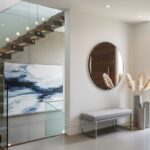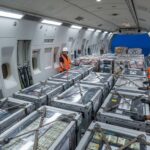Quire is a Portland based mixed media artist, who discusses her series Science of Change, previous grant experience and collaging.
What is it about the human connection that interests you and why are you drawn to making work through many voices?
It’s just how my mind works. When I was in college my dorm room was like an advice column. Girls, (I say girls because the dorms were not co ed) would come to my room and ask advice about anything and everything in their lives. Maybe it is a combination of my innate sensitivity as a creative and needing to read the emotions of my parents really well in order to navigate growing up in an alcoholic household, but my mind is just constantly interested in how we communicate, connect, and get along.
I also think that our technology filled lives enable us to only be surrounded by people and information that make us totally comfortable and just disconnect from others completely. It is important that we don’t lose our ability to connect with and understand other people and cultures.
I think it’s a safe form of empathy. Growing up if I saw an injury on someone I would literally feel a pain in the same place on my body. I couldn’t watch anything with violence because it would make me physically nauseous. By making work like this I can feel the struggles of others while working out my own. This allows me to understand others and myself more deeply without having my empathy overwhelm me.
If I am honest with myself I am equal parts accepting and judgy as hell so I have to walk a fine line of being honest with my opinion and identity while being totally open to give voice to the thoughts and ideas of others. The ability to do this is important, as I talk about experiences which may not be my own. I need to be have this discussion without exploiting others. For example, I have done pieces about race, but I am a middle age (almost) white lady. I have also done pieces about the LBGTQ community but I identify and a sis-gendered person in a monogamous relationship. Some might ask what right do i have to talk about any of this stuff? It is complicated but I always approach these themes from a place of empathy, openness, and support. It may not be my specific cultural experience but I live in a community with these individuals so I am connected to them and their experiences and want to understand them more deeply.
Talk about the evolution of your work. Did you start out as a painter? What made you move into mixed media/plexiglass?
My degree is in Studio art, meaning I studied most of the traditional forms of fine art, painting, sculpture, pottery, photography. I chose painting as my emphasis because the painting professor was the only cool person on the faculty. That was important because that meant he would be my mentor for two years.
After school, I had some disappointing life events and I couldn’t make art for along time (for the first time in my life). I got back into creating through collage because it was financially and emotionally accessible for me at the time. When I was ready to start painting again I couldn’t figure out what to paint. I didn’t want to do still-lifes or landscapes, or abstract non-objective work, all of which I did in school and felt that wasn’t for me. I wanted to paint something that communicated ideas that I didn’t know how to voice yet.
At this time I also started working at an art supply store, which gave me an amazing education in materials that blew what I learned in art school out of the water.
So those two things, my studio community and the art supply education, lead me to working with mixed media. I no longer carefully cut out and paste the images down to a static collage. I go into a piece with a general idea of what I want to communicate so searching for images is now more intentional.
I find images that I feel communicate a basic concept and draw them to create a layout for how they would be placed to the final work. This allows me to change their size and transparency in relation to how they will work together in the overall composition and to determine what type of mixed media i will incorporate into the piece.
Plexiglass came into play when I wanted to figure how to take forms outside of the strict rectangular canvas shape. My process still includes image harvesting with old school magazines and newspapers, I just use more resources now, like real people and the internet.
I started by finding individuals who followed certain criteria. First they had to be an interesting person who could potentially have some good life experiences to draw from in their interview. I also wanted to have some amount of diversity in the individuals I chose, body type, age, race, socioeconomic background ect. Some people I interviewed were long time friends, some acquaintances, and some random strangers I met at my day job or barely knew from Facebook. I filmed interviews with 11 people asking them to talk about stories of change in their lives.
Trillium is a mental health facility for kids and young adults so they had to find interviews that were appropriate for their clients. Five were chosen and I then went back and painstakingly found expression stills from each interview that communicated the emotional arch of the individual’s story.
I had any where from 50-100 expression stills for each person and I chose three of the best from each interview to make the work from. The most challenging parts were finding the expressions and editing the interviews. Filming and editing were new skills I had to learn for this project.
Luckily, I am good friends with a local film maker, he taught me how to use the editing software and did a few things that were just out of my depth. I also collaborated with a builder friend to build custom installation hardware. I loved how collaborative this project was, both with using actual people for the subject matter and employing the skills of other creative professionals.
I really loved partnering with a mental health nonprofit to show the work to an audience that usually wouldn’t be exposed to fine art in their daily environment. It was really cool to find out that my work could be inspirational in a really genuine and specific way to the Trillium clients and and staff and also find unconventional ways to expose my work to my community.
Was this the first time you used interviews to fuel your work? How did the interview process surprise or disappoint you?
The Science of Change is the first time I used interviews to find source imagery. I imagined myself as the artist version of Terry Gross from Fresh Air, but let me tell you, she makes interviewing people look way easy! It is not. Some of the individuals I interviewed were good friends so the conversational interview style I was going for was very natural with them. Other people were Facebook acquaintances and I found out pretty quickly that it takes skill to get people to talk about themselves.
In 2015 you received professional development grant from the RACC. Can you talk about what made you decide to apply for this grant and walk us through the process?
My art making practice is designed to always challenge me and make me learn new skills with every series I create. I decided to apply for the professional development grant because I had just discovered that I loved working with plexiglass but it was difficult to cut with the tools and knowledge I possessed. It is also expensive to have others do it for me so it would not be financially sustainable to have to depend on that for the plexi I needed.
I applied for a grant to pay a 5th generation woodworker who restored and built boats, to teach me to use all the tools in his shop to cut plexiglass and build customized structures that made my conceptual designs a reality. I needed to be able to imagine a piece outside of a prescribed canvas and be able to actually build and create it. I also wanted to learn the skill of applying for grants, which is no small task, and the professional development grant is a good one to start with.
RACC is a great organization that really wants to help artists increase their skill and get paid for it. When applying for a grant it is important to have a clear vision of what it is you are hoping to achieve and be able to effectively communicate that vision. It is also important to have a clear and strategic budget. Don’t be afraid to ask lots of questions before sending in your final application. It takes a lot of research and a lot of writing.
I learned how to do precision measuring and how to build complicated wood structures as a part of learning how to use the tools in the wood shop. I learned how to cut complicated shapes out of giant pieces of plexiglass. The two most important things I learned, was that if I can imagine it there is a way to build it and I discovered what I am comfortable doing by myself in my studio practice and when I need to seek help from others to make my vision come to fruition. I feel that between those two lesson I can take my work in any direction I want it to go!
I’m a featured artist at Basic Space gallery in the Pearl, where I’ll be showing the sixth and last installment of my Science of Change series, for the month of September. I am really excited to show this last piece because the interview was so compelling, I cried while editing it.In October I’m in a group show at gallery fifty24PDX at Compound in Chinatown and also doing Portland Open Studio tour. I love Portland Open Studio, it is the longest running and only juried studio tour in our city, so people who take part in visiting artist’s studios all around town for this event are very serious and excited about the art and artists they meet. The tour is a wonderful way for us artists to connect with our community and I’m really stoked to be doing it this year. The tour takes place the second and third weekends in October so come out to my space and see what I’m up to!
The thing I can’t wait to get started on is a new series I have had in my head for months. I am calling it Square Peg Round Hole and it’s all about how in life we sometimes have to go through stages of awkward discomfort to realize what fits us, whether that be a culture, a job, a relationship, a gender, it’s a pretty universal experience.
I’ll be collecting images of real people in poses that indicate a stretching or breaking free of an imaginary box around them. I am contemplating settling up a rope and pulley system in my studio that will act as the borders of the box and inviting people from my community to pose in it for a photoshoot. If you want to be my subject please come on by! I will take those images and use them as source material for my work. I plan on placing them in wood boxes and manipulating the wood so it looks like the figures are actually moving it.
My hope with my work is that I am a connector or conduit. I want people (myself included) to be more deeply connected to their truth, to the beauty of others, to the wonder of our world. I draw from the human experience for inspiration of what I want to discuss because I feel it so big and so small at the same time and there is a sense of mystery and awe within that paradox. Within that mystery there is so much to explore and understand, I hope I am creating work that helps us tap into that discussion and find our place within it.










